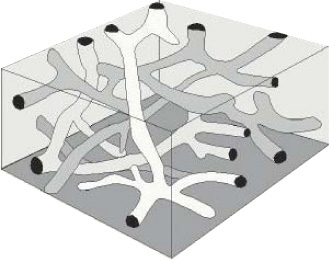Calgary Building Stone Tour: Tyndall Limestone EarthCache
Calgary Building Stone Tour: Tyndall Limestone
-
Difficulty:
-

-
Terrain:
-

Size:  (not chosen)
(not chosen)
Please note Use of geocaching.com services is subject to the terms and conditions
in our disclaimer.
This EarthCache is the first in the Calgary Building Stone Tour
aimed at highlighting the remarkable decorative building stones
used to ornament many of Calgary’s buildings.
Note: The cache is not limited to the posted
coordinates. This cache may be logged at any building in Calgary
decorated with this building stone.
Limestone is commonly used as building stone in North America, but
Tyndall Limestone is unique. The colour, beauty, strength and
durability of Tyndall Limestone has allowed for it to be used in a
variety of ways and architectural styles. Tyndall Limestone is used
extensively as an ornamental building stone across Canada.
Look at the walls next time you see a news report from the halls
of the Parliament in Ottawa. The backdrop of elaborately carved
walls, columns, and ceilings are made of Tyndall Limestone. Other
notable buildings adorned with Tyndall Limestone include the
Canadian Museum of Civilization in Gatineau, the Manitoba
Provincial Legislature in Winnipeg, the Rimrock Hotel in Banff, the
Empress Hotel in Victoria, the Provincial Museum of Alberta, and
the University of Alberta’s Tory Building. Several buildings of
downtown Calgary are also decorated with the ornamental building
stone. The first building to be adorned with Tyndall Limestone was
Fort Garry in Manitoba in 1832.
Occurrence and History of the Tyndall
Limestone
Tyndall Limestone is an informal term applied to building stone
from the Selkirk Member of the (Ordivician) Red River Formation.
The best exposures of the Tyndall Limestone are found in the
Garson-Tyndall area, approximately 30 km northeast of Winnipeg,
Manitoba. The small village of Garson Manitoba bills itself as The
Limestone Capital of North America. This is no empty boast, the
limestone quarried here is probably the most frequently used
building stone in Canada. The name of the stone comes from Tyndall,
the closest railway point to the quarries; the railway station was
itself named after the noted British physicist Professor John
Tyndall.
Description of the Tyndall Limestone
Tyndall Limestone is a fine grained light coloured, fossil-bearing
limestone (wackestone) with comparatively darker brown coloured
fine to medium grained medium tubular-shaped (vermiform) branching
network of dolomitic limestone, which give the rock a ‘mottled’
appearance.
Two major types of fossils occur in Tyndall Stone. The first are
body fossils. These are the calcite shells of a variety of marine
animals and plants that lie dispersed throughout the rock -- like
raisins suspended in a pudding. The second are trace fossils that
occur as a pervasive network of burrows.
Body Fossils of the Tyndall Limestone
Body fossils are the hard, shelly remains of organisms preserved
within a rock. Tyndall Limestone is notable for its rich variety of
large, excellently preserved, easily-identifiable body fossils. A
close look at Tyndall Limestone will reveal many interesting
fossils embedded within it. The following is a non-inclusive list
of the most abundant fossils of the Tyndall Limestone that you may
find:
Cephalopods are like modern squids or nautili.
Cephalopods with straight shells are called Orthocone, whereas
those with a curved shell are known as Winnipegoceras.
Gastropods (Maclurites) are more commonly
known as snails and slugs. On a cut surface, the fossil may have a
coiled appearamce.
Chain Coral (Favosites) are colonial coral
that have an irregular grid pattern that sometimes resembles a
distorted chain-link fence.
Horn Coral (Grewingka) is a solitary
coral. In the rock the fossil has a pattern of line radiating out
to an oval or a horn-like pattern.
Sunflower Coral (Receptaculites), are the
largest and most enigmatic of the Tyndall fossils. Don’t let the
name fool you, they are not a corals, but actually calcareous
algae. The fossil occurs as a circular colony, characterized by a
uniform grid pattern and a distinguishable deep hollow in the
centre.
Brachiopods and trilobites may
also be present but are more difficult to identify. When examining
the rock for fossils, keep in mind that the shape of the fossil
displayed may vary considerably depending of the random
cross-section on the exposed surface of the building stone.
Trace Fossils
The shelly fossils of Tyndall Stone are certainly intriguing, but
it is the trace fossils that make this limestone an attractive
building stone. Unlike body fossils, trace fossils are fossilized
tracks, trails, or burrows left during the day-to-day life
activities of an organism. You may have unknowingly created trace
fossils with your own footprints, if they were subsequently filled
with sediment, buried and preserved in the geological record.
In Tyndall Limestone, the trace fossils are evident as a ‘mottled’
texture. The mottled areas have a tubular, vermiform shape that
branch and bifurcate, extending as deep as a metre below the seabed
surface. This image is a schematic block diagram of what the
network of burrows might look like in three dimensions.

These trace fossils are well-known to ichnologists (those who study
trace fossils) as Thalassinoides. Since the Cretaceous,
Thalassinoides tunnels have been excavated as dwelling and
feeding burrows by mole shrimp. However, it is unlikely that mole
shrimp or any other decapod crustacean made these deep burrows in
the Ordovician because these arthropods have a well-documented
fossil record that starts 250 million years later in Jurassic
rocks. So what animal made these burrows? Unfortunately, no body
fossils have been identified in or near the burrows to give even a
suggestion. One is tempted to say "worms", but when paleontologists
attribute a trace in sediment to the activity of "worms" it is
generally an expression of ignorance rather than an actual
identification. We simply don't know what animal is responsible for
the deep burrows and the mottles in Tyndall Stone.
The difference in colour between the burrows and the surrounding
rock is due to differences in grain size and chemistry. As the
animals burrowed through the soft, limey mud, they lined their
burrows with slime to add strength to their tunnels. Furthermore,
the sediment inside their burrows is loosened and reworked,
compared to the more tightly packed surrounding mud that hardened
before the less dense sediments in the burrows. Later,
magnesium-rich waters percolated through the rock and deposited
dolomite in the burrows, but couldn't penetrate the tightly
cemented limestone rock. The darker colour of the burrows may be a
result of oxidation of trace amounts of iron in the dolomite, or of
pyrite that was deposited along with the dolomite.
Depositional Environment
Four hundred and fifty million years ago (late Ordovician Period),
the environment of present-day southern Manitoba was a warm,
shallow, inland sea, just south of the equator. Many different
types of animals lived in this ocean. Some, such as corals,
sponges, molluscs, and algae, are still around today. Others, such
as trilobites and stromatoporoids, are extinct. All of these
creatures lived just below, on or above the soft, muddy sea floor.
After they died, their remains became part of it. The calcium
carbonate in their skeletons made the mud limey, so that when it
hardened into rock it became limestone. Fossils of these animals
and plants are visible today in Tyndall Stone. Other animals
burrowed in the mud of the sea floor for food or protection. And it
is the preserved burrows of these creatures that make the beautiful
mottling which gives Tyndall Stone its unique appearance.
More information can be found at the following site:
www.epl.ca/ResourcesPDF/Fossilsofcityhall.pdf
To log this cache:
In order to log this cache, you must:
- Estimate the average thickness of the burrows and email me the
answer
- Estimate the percentage of the rock that is composed of burrows
and email me the answer
- Take a picture of at least one body fossil with your GPS for
scale and identify it. Please post your answer as the picture
caption. I will be lenient with answers, but I will not accept 'I
don’t know'. Take a look at previous pictures to help you identify
your fossil. If you are unsure, post your picture anyway and take a
guess. If you are incorrect, I will help you identify it. All I ask
is that you modify the caption to the right answer because it will
help subsequent finders identify the fossils they have found.
- State the building and post your (best possible) co-ordinates of
where you made your observations in your log
Logs without an accompanying email or the required photo will be
deleted. Do not post a log for this EarthCache until you (a) have
emailed the answers and (b) are prepared to post the photo.
Happy EarthCaching!
References:
Canadian Society of Petroleum Geologists, 1997. Lexicon of Canadian
Stratigraphy, vol. 4: Western Canada. ed. D.J. Glass.
Geological Survey of Canada, 2006. Past Lives: Chronicles of
Canadian Paleontology - Tyndall Limestone.
http://gsc.nrcan.gc.ca/paleochron/17_e.php
Dixon Edwards, W. A., 2004. EUB/AGS Rock Walk IV - A Rock Walk
Through Downtown Edmonton. C. I. M. AGM tour and guidebook, May 12,
2004; in AGS Rock Chips, Fall/Winter 2003 edition.
http://www.ags.gov.ab.ca/publications/pdf_downloads/rockwalkhandout.pdf
McCracken, A.D., Macey, E., Monro Gray, J.M., and Nowlan, G.S.,
2007. Tyndall Limstone in GAC’s Popular Geoscience.
http://www.gac.ca/PopularGeoscience/factsheets/TyndallStone_e.pdf
Mussieux, R., and Nelson, M., 1998. Urban Geology: Building Stone
of the Provincial Museum and Government House. In: A Traveller’s
Guide to Geological Wonders of Alberta.


Additional Hints
(No hints available.)